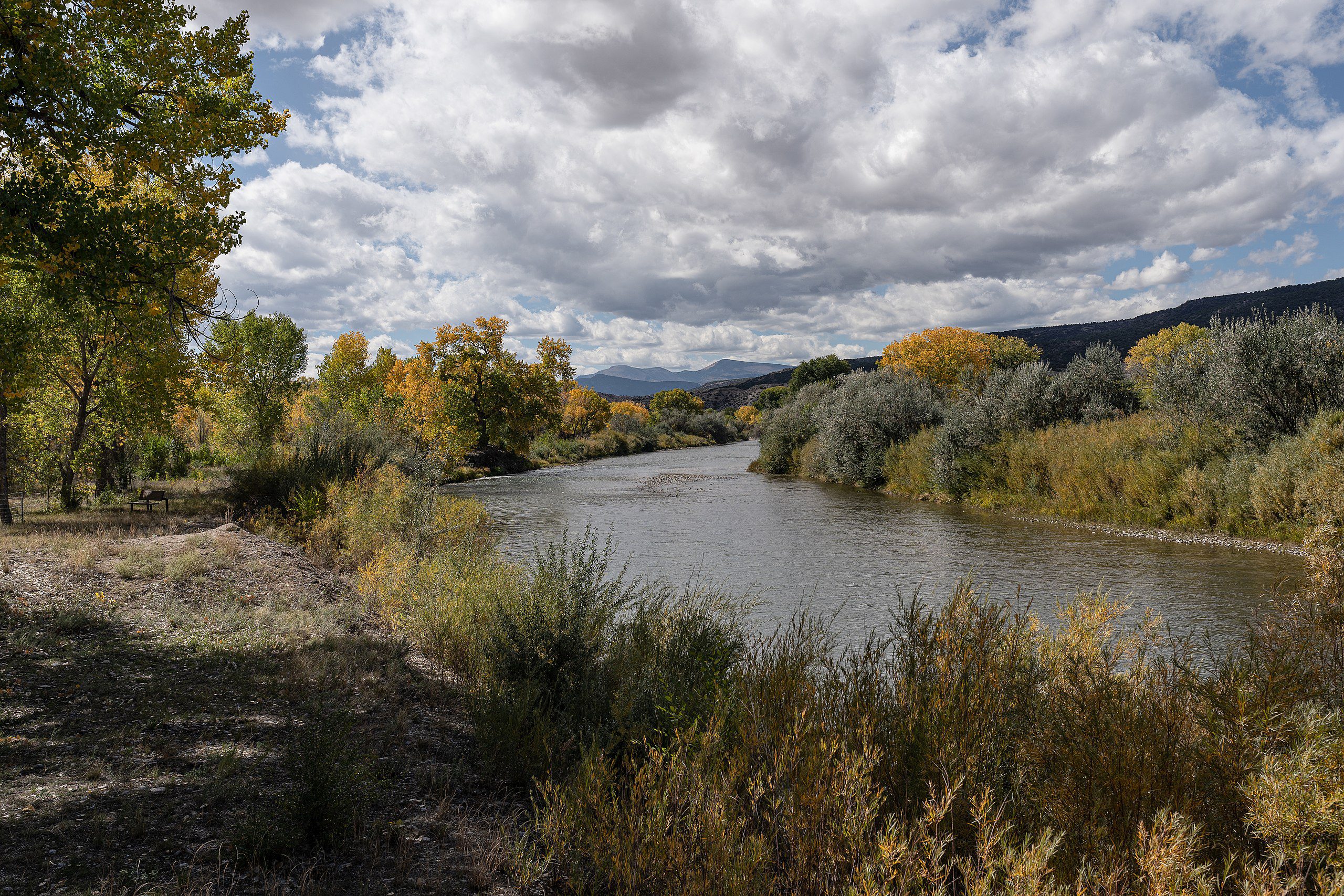- US Supreme Court rejects Rio Grande water deal between states
- Federal government intervenes, citing concerns about New Mexico pumping
- States and feds disagree on impact of groundwater pumping on water deliveries
- Case returns to Supreme Court, leaving future of Rio Grande management uncertain
- New Mexico’s outgoing state engineer calls for regional approach to water challenges
July 14, 2024, republished from July 9 Source New Mexico article by Danielle Prokop — With the irrigation season still going strong, and recent rains temporarily swelling the Rio Grande, the river is running through most of New Mexico.
— With the irrigation season still going strong, and recent rains temporarily swelling the Rio Grande, the river is running through most of New Mexico.
In court, the case over the river’s water is in a lull, after the U.S. Supreme Court rejected a deal to end a lawsuit over the water flowing at about just under 5 feet deep at the border between Texas and New Mexico.
Mike Hamman, a central figure in the case, is stepping aside as his retirement from the State Engineer’s position went into effect after the decision came down.
Hamman called the Supreme Court’s decision a setback, in an interview with Source NM. He’s unsure how long it will take to resolve Rio Grande management between three states – Colorado, New Mexico and Texas – and now the federal government.
“The bottom line is that we do have a significant issue to address in the Lower Rio Grande,” he said. “It means now going back into another possible trial process, or working towards another stab at mediation.”
A deep guide to people and terms in the Rio Grande SCOTUS case
Hamman said that the Rio Grande is already under pressure from climate change, and that reducing groundwater pumping in the area is a priority, even as the case continues.
“We’re going to work with our stakeholders in the basin to try to get ourselves back in balance,” he said. “This is a perpetual drought setting, and we have to prepare for even more austere times with climate change, changing the whole hydrologic cycle.”
‘Up the river’
It’s been more than a decade since Texas filed its complaint in 2013 that New Mexico groundwater pumping below Elephant Butte was taking water owed to Texas, violating the 1938 Rio Grande Compact, an agreement to split the river.
The case, called Original No. 141 – has shifted significantly, as the states of Colorado, New Mexico and Texas developed a deal to end the litigation last year, pitting the parties against the federal government.
The high court allowed the federal government to intervene in the case in 2018, when it raised concerns that New Mexico pumping threatened the U.S. Bureau of Reclamation’s ability to deliver water to Mexico and regional irrigation districts, and mirrored many of Texas’ claims.
The three states put forward a proposed deal that they say resolved the interstate disputes, and would address further concerns between the federal government and New Mexico in lower federal district courtrooms.
The deal – formally called a consent decree – would have added a new gage to measure water deliveries at the Texas-New Mexico state line, factored in new drought and groundwater pumping calculations and officially split the water below Elephant Butte Reservoir 57% to southern New Mexico and 43% to Texas.
The federal government objected that the deal imposed conditions they didn’t consent to.
In late June, the court sided with federal objections to the deal, and said the case will continue before the U.S. Supreme Court.
The majority opinion argued that the court previously allowed the federal government to intervene as a party in the case, to protect its “distinct federal interests.” Those include the maintenance and operation of a network of dams and canals that deliver water to Mexico and regional irrigation districts.
“Having acknowledged those interests, and having allowed the United States to intervene to
assert them, we cannot now allow Texas and New Mexico to leave the United States up the river without a paddle,” Justice Ketanji Brown Jackson wrote for the majority opinion.
Jackson continued, writing that the federal government is allowed to pursue the claim that New Mexico’s groundwater pumping violates the compact.
“That Texas’s litigation strategy has since changed, such that it is now willing to accept a greater degree of groundwater pumping, does not erase the United States’ independent stake in pursuing claims against New Mexico,” she wrote.
In the dissent, Justice Neil Gorsuch – joined by Justices Samuel Alito, Clarence Thomas, and Amy Coney Barrett – said the ruling overturned water law precedents, allowing more leeway for the federal government to intervene.
“In that way, too, I fear the majority’s short-sighted decision will only make it harder to secure the kind of cooperation between federal and state authorities reclamation law envisions and many river systems require,” Gorsuch wrote in the dissent.
Gorsuch writes that the court’s rejection leaves the states “only with the promise of more litigation to follow,” and no deal.
Court watchers react
The ruling’s makeup and breadth was a shock to observers, said Gage Zobell, a water attorney at Dorsey & Whitney based in Salt Lake City, Utah, who has consulted on some water cases in New Mexico.
“That was a step even beyond what I ever would have imagined they would have come out with, even had they decided to not approve the consent decree,” Zobell said.
Zobell described the ruling as allowing the federal government’s position to “hold the settlement hostage,” and require more action from New Mexico on limiting groundwater pumping.
The ruling is limiting the use of a 1938 precedent of deferring to upstream states to manage water governance, said Burke Griggs, a national water law expert and professor at Washburn University School of Law.
“There’s a real tension here between how the majority and the dissent understand how an interstate compact works in our federal system,” Griggs said.
Griggs said the decision could embolden the federal government to intervene in water compact disputes between states, even if it’s not a party to them.
“I think that’s a valid concern – but whether the United States actually will, is another question,” he said.
U.S. Supreme Court questions both positions in Rio Grande water case
What’s next?
Hamman’s replacement at the Office of the State Engineer will inherit the continued legal fight over the Rio Grande waters, as the state agency oversees New Mexico’s streams, rivers and lakes but also the groundwater beneath our feet.
Hamman said the challenges facing the state from determining tribal water rights, water-sharing plans, supply and management should be refocused at a regional level, since the challenges for each basin are unique.
The state is working to revamp the rules on regional water planning after passing the 2023 Water Security Planning Act, and make the process less top-down than prior years.
The state is hosting open houses starting July 17, to address the regional boundaries and more before the planning scheduled for later this year.
Hamman said he believes that regional planning balances environmental concerns and the economy.
“Having the ability for those regional entities to advise their legislators on what their needs are, will help them make good-priority decisions every session, as opposed to just kind of catching kicked cans and putting Band-Aids on problems,” Hamman said.
Source New Mexico is part of States Newsroom, a nonprofit news network supported by grants and a coalition of donors as a 501c(3) public charity. Source New Mexico maintains editorial independence. Contact Editor Shaun Griswold for questions: info@sourcenm.com. Follow Source New Mexico on Facebook and X.
Image Credit:
The Rio Grande bordering the property of the Los Luceros ranch complex near Alcalde, New Mexico , by Matthew Kowal, October 2021. Licensed under the Creative Commons Attribution-Share Alike 4.0 International license.
, by Matthew Kowal, October 2021. Licensed under the Creative Commons Attribution-Share Alike 4.0 International license.



Leave a Reply